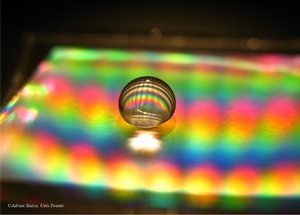Dec 4 2008
It will soon be possible to measure ultrasonic sound using water, air, light and nanotechnology - over a hundred times more accurately than with existing sensors. This innovative method is based on a new principle for an ultrasound sensor developed by Helmut Rathgen of the University of Twente. The new sound sensor enables accurate ultrasound scans with a small mobile device and can be used to improve the sonar equipment used on boats. Mr Rathgen was awarded his doctorate on 3 December at the faculty of Science and Technology.
 In the ultrasound sensor, the interface between water and air acts as a membrane. The vibrations of this membrane are measured using light.
In the ultrasound sensor, the interface between water and air acts as a membrane. The vibrations of this membrane are measured using light.
The sensor designed by Helmut Rathgen consists of a glass fibre in which a hole measuring a few hundred nanometres has been bored; a hole many times smaller than a hair. The fibre is placed in a water droplet, so that a miniscule air bubble is created in the cavity. The interface between this air bubble and the water acts as a membrane which begins to vibrate under the influence of ultrasonic sound. The intensity of the sound can be determined by measuring the extent to which the interface vibrates.
The extent of this vibration is measured using a beam of light that is led through the glass fibre. Some of the light reflects against the interface. If the interface begins to vibrate, the intensity of the ultrasonic sound can be determined on the basis of the change in the reflection of the light.
Mobile ultrasound scans
The new sensor is over a hundred times more accurate than existing ultrasonic sound sensors and can be used for many applications. For instance, the sensor can be used in ships which, just like bats, make use of ultrasonic sound to map their environment. The sensor can also be used to improve medical sound scanning. Scans are used for various purposes including following the growth of unborn babies in the uterus. Since the sensor measures very accurately, the body only has to send out a very weak signal to be picked up. This means that it will be possible to make ultrasound scans with a small, battery-powered mobile device in the future.
Innovation Award
The PhD student was presented with the NanoNed Innovation Award for his invention on 19 November. The objective of this prize is to encourage young researchers to translate their scientific work into a business idea that meets a demonstrable market need.
The University of Twente has applied for a patent on the invention and will be developing the principle into a ready-to-use product in cooperation with a company in the region.